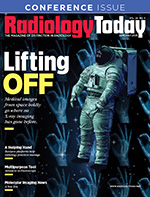Cover Story
Lifting Off
X-ray technology in space breaks new ground for imaging portability and further promotes the health and well-being of astronauts.
Featured Articles
A Helping Hand
Numerous emerging AI business platforms aid radiologists in balancing various imaging and administrative tasks.
Multipurpose Tool
Various fluoroscopy advancements are improving the modality by enhancing diagnostic precision and patient care.
| Web Exclusive l View Archives Farther Afield |
By Shabaz Khan, BA; Karen Makhoul, BS; and Anna Luisa Kuhn, MD, PhD
History
A 71-year-old female with a past medical history of osteoarthritis, hypertension, hyperlipidemia, depression, and macular degeneration presented with hip pain following a mechanical fall at work. The patient landed on her right hip and struck the left side of her head, but did not lose consciousness. CT of the head and pelvis were obtained as part of the trauma workup. Continue reading »
History
A 71-year-old female with a past medical history of osteoarthritis, hypertension, hyperlipidemia, depression, and macular degeneration presented with hip pain following a mechanical fall at work. The patient landed on her right hip and struck the left side of her head, but did not lose consciousness. CT of the head and pelvis were obtained as part of the trauma workup. Continue reading »
powered by AHCJobBoard.com


